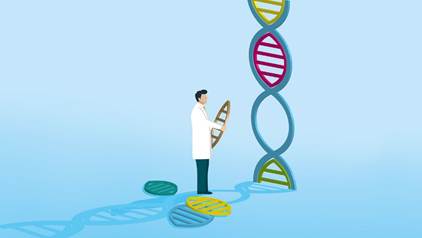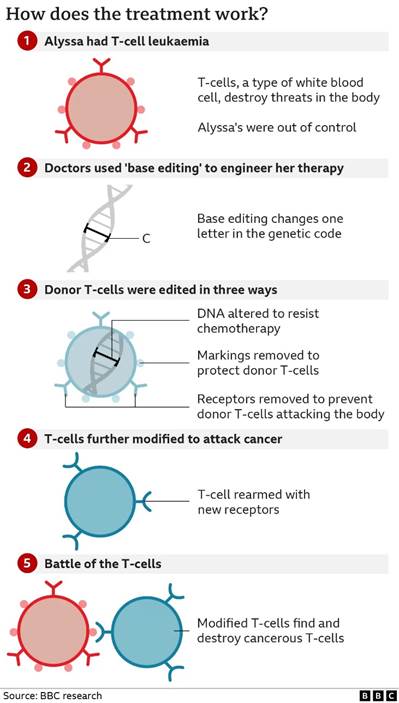BASE EDITING

Disclaimer: Copyright infringement not intended.
Context
- For the first time, a new gene editing technology called base editing was used to modify immune cells and successfully treat a teen with treatment-resistant leukemia.
- A month afterward, 13-year-old Alyssa was in remission, and she continues to do well several months later.
What was the disease Alyssa suffered from?
- Alyssa was diagnosed with a kind of blood cancerknown as T-cell acute lymphoblastic leukaemia (T-ALL).
- T-ALL affects the stem cells in the bone marrow that produce a particular kind of white blood cells (WBC) called T lymphocytes (T cells). These cells provide a person immunity by killing cells carrying infections, activating other immune cells, and regulating the immune response.
- At least 20% of these WBC are atypical – as they accumulate in the bone marrow, they crowd out “good” WBCs and hence weaken the immune system. These unhealthy cells can also accumulate in other parts of the body like the liver, spleen and lymph nodes.
- While found in both children and adults, T-ALL’s incidence decreases with age.
|
T Cells and T-ALL T cells are a part of the immune system that focuses on specific foreign particles. Rather than generically attack any antigens, T cells circulate until they encounter their specific antigen. As such, T cells play a critical part in immunity to foreign substances. T-cell acute lymphoblastic leukemia (T-ALL) is an aggressive malignant neoplasm of the bone marrow. It accounts for ∼20% of all cases of ALL and is somewhat more common in adults than children, although the incidence diminishes with older age. |
How is T-ALL typically treated in general?
- Typical treatment for T-ALL is similar to that of any leukaemia– chemotherapy and stem cell/bone marrow transplant. Doctors will first administer multiple rounds of chemotherapy. This either kills the cancerous cells or stops them from further dividing. The exact schedule is guided by an individual’s age and general health.
- If this fails, and the individual is suitable, doctors will conduct a bone marrow transplant. First, the patient will undergo radiation therapy and/or chemotherapy that will kill the cancerous cells but also wreck an individual’s immunity system along with it. Thus, patients receive an infusion of healthy bone marrow cells that will hopefully multiply and restore immunity.
- Overall treatment for T-ALL is pretty effective– children have a survival rate of over 85 per cent after five years of receiving this treatment. Unfortunately, Alyssa lay in the unlucky 15 per cent of children where the treatment just did not work.
The Treatment
- The treatment is a modification of chimeric antigen receptor, or CAR, T-cell therapy. But instead of using the CRISPR gene editing techniqueto modify the patient’s immune cells, the clinicians used the more precise base editing technique to alter donor immune cells.
- Those edited cells are given to the patient to “rapidly find and destroy T-cells in the body, including leukemic T-cells.
What is the experimental treatment Alyssa received?
- Alyssa, began a trial where she received a dose of healthy T-cells from a donor that would hopefully attack her cancerous cells without destroying each other. Known as CAR-T therapy, this principle has been around for a while, but Alyssa’s case was different.
- Traditionally, CAR-T therapy involves adding a gene to T-cells that causes them to seek out and destroy cancerous cells. The modified cells are known as CAR-T cells.
Mechanism
- First, an individual’s own T-cells are removed, which are then modified and reintroduced to the individual. The problem with such an approach (besides the expense) is that very often, when an individual is really sick, it is simply impossible to obtain enough healthy T-cells to create CAR-T cells.
- While donors can provide healthy T-cells to an individual, these T-cells from a foreign body are going to attack every single cell in that patient’s body, making the treatment counterproductive.
- Thus, scientists have resorted to what is known as base editing– through this technique of genetic editing, they make it possible for one donor to supply T-cells to multiple recipients, without the traditional risks associated with it.
- Thus, Alyssa received genetically modified cells that were programmed to specifically attack her cancer while leaving the rest of her body alone.
What is Base Editing?
- Base editing allows scientists to zoom to a precise part of the genetic code and then alter the molecular structure of just one base, converting it into another and changing the genetic instructions.
|
What are bases in DNA? Molecules called nucleotides, on opposite strands of the DNA double helix, that form chemical bonds with one another. These chemical bonds act like rungs in a ladder and help hold the two strands of DNA together. There are four nucleotides, or bases, in DNA: adenine (A), cytosine (C), guanine (G), and thymine (T). They function as the fundamental units of the genetic code. The information in DNA is stored as a code made up of these four chemical bases. The order, or sequence, of these bases determines the information available for building and maintaining an organism, similar to the way in which letters of the alphabet appear in a certain order to form words and sentences. |
- With advances in genetic technology, scientists have been able to zoom into a precise part of the genetic code to alter the molecular structure of just one base, effectively changing its genetic instructions.
Why is base editing better than CRISPR?
- Conventional CRISPR-Cas9 gene editing (left panel) introduces double-strand breaks, which can lead to off-target effects. Base editing (right panel) avoids double-strand breaks, thereby minimizing errors.
- Thus, Base editors allow precise nucleotide substitutions in the DNA without having to break the DNA to force the cell machinery to repair it and in the process make mistakes, which is the main mechanism of CRISPR-Cas9.
The recent Treatment
- Scientists managed to use base-editing to create a new type of T-cell from a healthy donor that would not attack other cells in Alyssa’s body, not kill each other, survive chemotherapy and finally, hunt down all other T-cells in Alyssa’s body (healthy and cancerous).
- After this therapy worked in its initial stages, Alyssa was given another bone marrow transplant to restore her immunity.

Significance
- Genetic manipulation is a “very fast-moving area of science” with “enormous potential” across a range of diseases. Success in Alyssa’s case will have a positive impact on the research that is conducted and ultimately benefit many patients.
- Base editing is particularly promising, not just in this case but for genetic disorders.
- Base editing is an even more precise gene editing technique than CRISPR and has fewer risks of unwanted effects on the chromosomes and thus less risk of side effects.
Must Read: CRISPR: https://www.iasgyan.in/daily-current-affairs/crispr



.jpg)
.jpg)
1.png)
